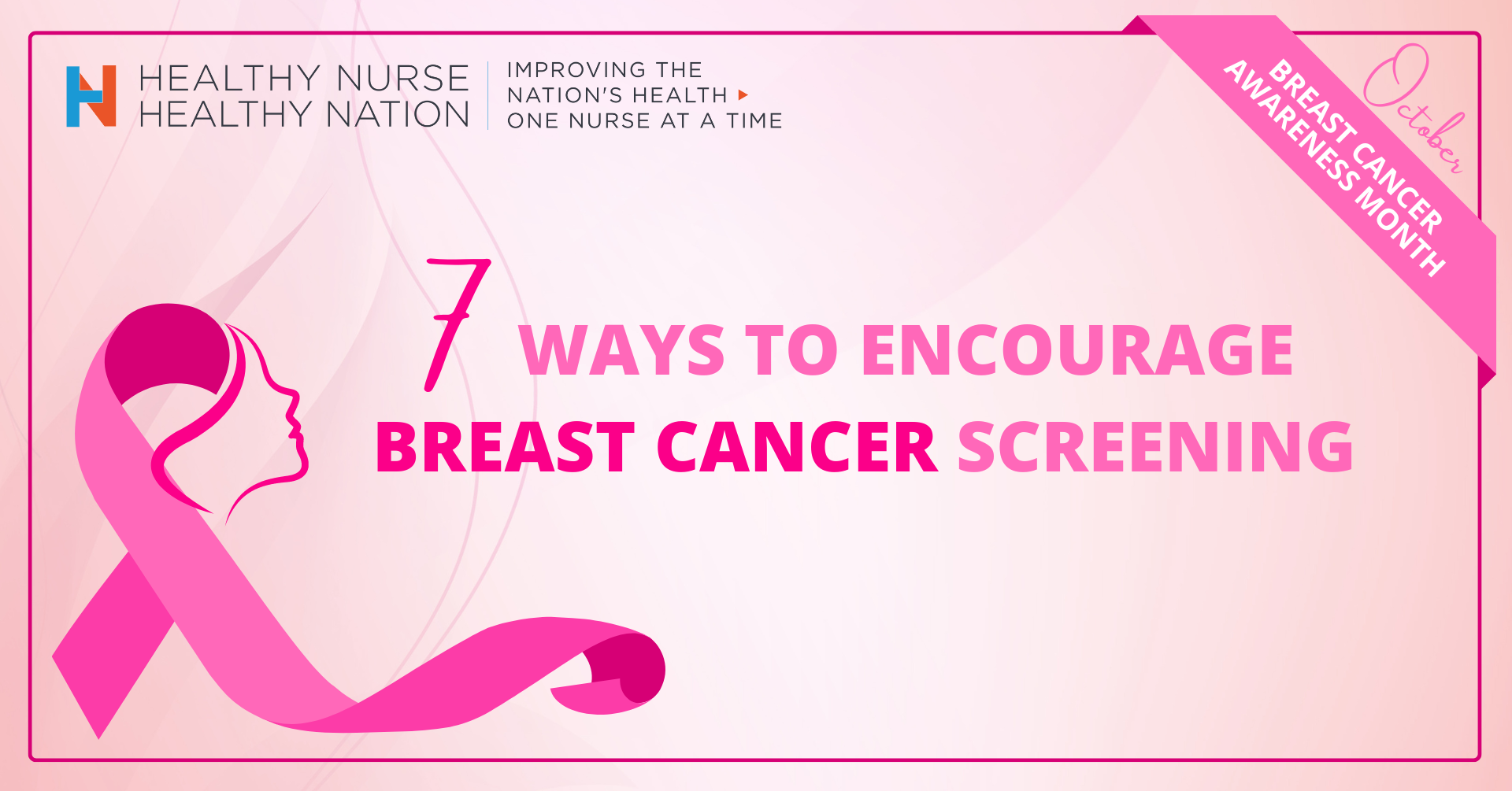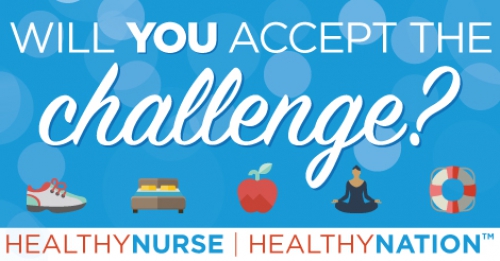Healthy Nurse, Healthy Nation™ Blog - 7 Ways To Encourage Breast Cancer Screening
Published
It’s no secret that screening can help find breast cancer at an early stage — when the chances for successfully treating the disease are the greatest. Unfortunately, those facts don’t always get passed on to patients, and many are reluctant to participate in breast cancer screening.
“Everyone has some risk, so we want to make sure we are helping patients take those steps toward early detection,” says #healthynurse Susan (Sue) Ferguson, DNP, MBA, RN, CPHQ, NEA-BC, INHC, who works as the clinical administrative director for the Nellie B. Connally Breast Center at the University of Texas MD Anderson Cancer Center. “Breast cancer screening measures are an effective means to reduce morbidity and mortality related to breast cancer.”
The good news is that, as a nurse, you are in a unique position to help people make breast cancer screening a priority. Nursing — commonly considered the most trusted profession — can provide opportunities to engage patients and offer the trust needed to positively-influence patients to screen for breast cancer. But that doesn’t mean the task is easy or always successful.
Obstacles to Patient Participation in Breast Cancer Screening
Everyone should practice awareness as a preventive measure for breast cancer by staying familiar with their breasts to recognize any changes. Specific screening recommendations for women over age 40 at average risk for breast cancer also include:
But urging patients to act on these preventive measures isn’t always easy. Patients don’t necessarily comprehend breast cancer risk, know the facts about screening, or understand the potential benefit. And in a busy health care setting, there may be few clinical opportunities to engage patients in a targeted discussion about breast cancer screening.
Even when those discussions do happen, many women delay or avoid their yearly screening mammogram due to:
“Nurses should be aware of the barriers to early breast cancer detection and screening,” Sue says. “Then they can take steps to remove those barriers and prepare the patient for screening.”
Encouraging Patients to Take Preventive Breast Cancer Measures
Urging patients to practice preventive care can take many forms. But it typically begins with awareness. To raise awareness of breast cancer and promote compliance with screening guidelines, try these 7 tips:
1. Identify and manage barriers
Patients aren’t always eager to share why they’re reluctant to have a mammogram. But if you ask the right open-ended questions, they might share what’s holding them back. Ask about their previous experience with a mammogram. Or ask why they haven’t gotten one yet.
“Once you know what the patient is up against, you can provide information, debunk myths, and educate about the importance of screening,” Sue says. “If there are concerns about discomfort, suggest ways to minimize the pain. If cost is an issue, social services may support breast screening.”
2. Advocate on your patient’s behalf
A breast cancer risk assessment can identify potential risk factors and guide recommendations for screening. But some patients may have trouble taking that next step — especially if they fear the outcome or the screening itself. Help coordinate patient screenings when needed and advocate on behalf of the patient with their clinical care team.
3. Support breast health education
Patients who don’t understand their risk or feel a false sense of security are less likely to participate in screening. They may even turn to unreliable internet sources. But when patients get information from their health care providers, they can rest assured the information is accurate and in their best interest.
“Nurses can design and implement educational programs that support patients with their breast health,” Sue says. “Knowing the reason behind ‘why it's important to get the screening’ could increase compliance.”
4. Promote healthy behaviors to reduce breast cancer risk
Screening isn’t the only preventive action that reduces the risk of breast cancer. Guiding patients to better lifestyle choices is also critical. Encourage patients to:
5. Raise awareness of male breast cancer
Men aren’t targeted for breast cancer screening, so they don’t often understand their risk for the disease. Raise awareness of breast cancer among male patients. Remind them that approximately 2,500 men in the United States are diagnosed with breast cancer yearly. Encourage them to practice awareness, just as women do, and to report anything unusual to their provider.
6. Look beyond the clinic
Keep current with breast cancer screening guidelines and look for ways to increase your knowledge of the disease. Educational opportunities can include web-based training, web conferences, and journals of continuing nursing education.
You can also be an advocate for breast cancer screening outside the clinic. In the community, look to participate in outreach activities that promote screening and provide education.
7. Be a role model
Patients often feel comfortable with nurses. Capitalize on that connection and influence others through your behavior. You’ll lead by example when you make your own breast cancer screening a priority.
Have you had success encouraging patients to take preventive measures for breast cancer? We’d love to hear what worked for you. Share with us in our discussion.

Not a member of Healthy Nurse, Healthy Nation (HNHN) yet? Join today!
Join our monthly challenges at hnhn.org/challenges.
The good news is that, as a nurse, you are in a unique position to help people make breast cancer screening a priority. Nursing — commonly considered the most trusted profession — can provide opportunities to engage patients and offer the trust needed to positively-influence patients to screen for breast cancer. But that doesn’t mean the task is easy or always successful.
Obstacles to Patient Participation in Breast Cancer Screening
Everyone should practice awareness as a preventive measure for breast cancer by staying familiar with their breasts to recognize any changes. Specific screening recommendations for women over age 40 at average risk for breast cancer also include:
- Getting an annual mammogram
- Having a clinical breast exam each year
But urging patients to act on these preventive measures isn’t always easy. Patients don’t necessarily comprehend breast cancer risk, know the facts about screening, or understand the potential benefit. And in a busy health care setting, there may be few clinical opportunities to engage patients in a targeted discussion about breast cancer screening.
Even when those discussions do happen, many women delay or avoid their yearly screening mammogram due to:
- Anxiety about the discomfort associated with mammograms
- False sense that they’re not at risk
- Fear of abnormal results
- Fear of radiation exposure
- No noticeable signs of breast cancer
- Outside factors including socio-economic issues, a language barrier, or a lack of support
“Nurses should be aware of the barriers to early breast cancer detection and screening,” Sue says. “Then they can take steps to remove those barriers and prepare the patient for screening.”
Encouraging Patients to Take Preventive Breast Cancer Measures
Urging patients to practice preventive care can take many forms. But it typically begins with awareness. To raise awareness of breast cancer and promote compliance with screening guidelines, try these 7 tips:
1. Identify and manage barriers
Patients aren’t always eager to share why they’re reluctant to have a mammogram. But if you ask the right open-ended questions, they might share what’s holding them back. Ask about their previous experience with a mammogram. Or ask why they haven’t gotten one yet.
“Once you know what the patient is up against, you can provide information, debunk myths, and educate about the importance of screening,” Sue says. “If there are concerns about discomfort, suggest ways to minimize the pain. If cost is an issue, social services may support breast screening.”
2. Advocate on your patient’s behalf
A breast cancer risk assessment can identify potential risk factors and guide recommendations for screening. But some patients may have trouble taking that next step — especially if they fear the outcome or the screening itself. Help coordinate patient screenings when needed and advocate on behalf of the patient with their clinical care team.
3. Support breast health education
Patients who don’t understand their risk or feel a false sense of security are less likely to participate in screening. They may even turn to unreliable internet sources. But when patients get information from their health care providers, they can rest assured the information is accurate and in their best interest.
“Nurses can design and implement educational programs that support patients with their breast health,” Sue says. “Knowing the reason behind ‘why it's important to get the screening’ could increase compliance.”
4. Promote healthy behaviors to reduce breast cancer risk
Screening isn’t the only preventive action that reduces the risk of breast cancer. Guiding patients to better lifestyle choices is also critical. Encourage patients to:
- Maintain a healthy weight by eating a mostly[KA1] plant-based diet and avoiding added sugar and unhealthy fat
- Exercise regularly, which helps lower breast cancer risk by regulating estrogen levels
- Limit alcohol intake, since alcohol raises the body’s estrogen levels and the risk of cancer
5. Raise awareness of male breast cancer
Men aren’t targeted for breast cancer screening, so they don’t often understand their risk for the disease. Raise awareness of breast cancer among male patients. Remind them that approximately 2,500 men in the United States are diagnosed with breast cancer yearly. Encourage them to practice awareness, just as women do, and to report anything unusual to their provider.
6. Look beyond the clinic
Keep current with breast cancer screening guidelines and look for ways to increase your knowledge of the disease. Educational opportunities can include web-based training, web conferences, and journals of continuing nursing education.
You can also be an advocate for breast cancer screening outside the clinic. In the community, look to participate in outreach activities that promote screening and provide education.
7. Be a role model
Patients often feel comfortable with nurses. Capitalize on that connection and influence others through your behavior. You’ll lead by example when you make your own breast cancer screening a priority.
Have you had success encouraging patients to take preventive measures for breast cancer? We’d love to hear what worked for you. Share with us in our discussion.

Not a member of Healthy Nurse, Healthy Nation (HNHN) yet? Join today!
Join our monthly challenges at hnhn.org/challenges.
Blog Safety
09/28/2022 2:01pm CDT



Post a Comment or Question